Oxytocin's Link To Autism

Exploring the Neurochemical Foundations of Social Behaviors in Autism
Autism spectrum disorder (ASD) is characterized by core deficits in social interaction, communication challenges, and repetitive behaviors. A growing body of research indicates that neurochemical systems, particularly oxytocin, may play a crucial role in the social difficulties observed in ASD. This article examines the scientific link between oxytocin and autism, the current state of research, biological mechanisms, and the therapeutic potential of oxytocin-based treatments.
The Role of Oxytocin in Social Behavior and Autism
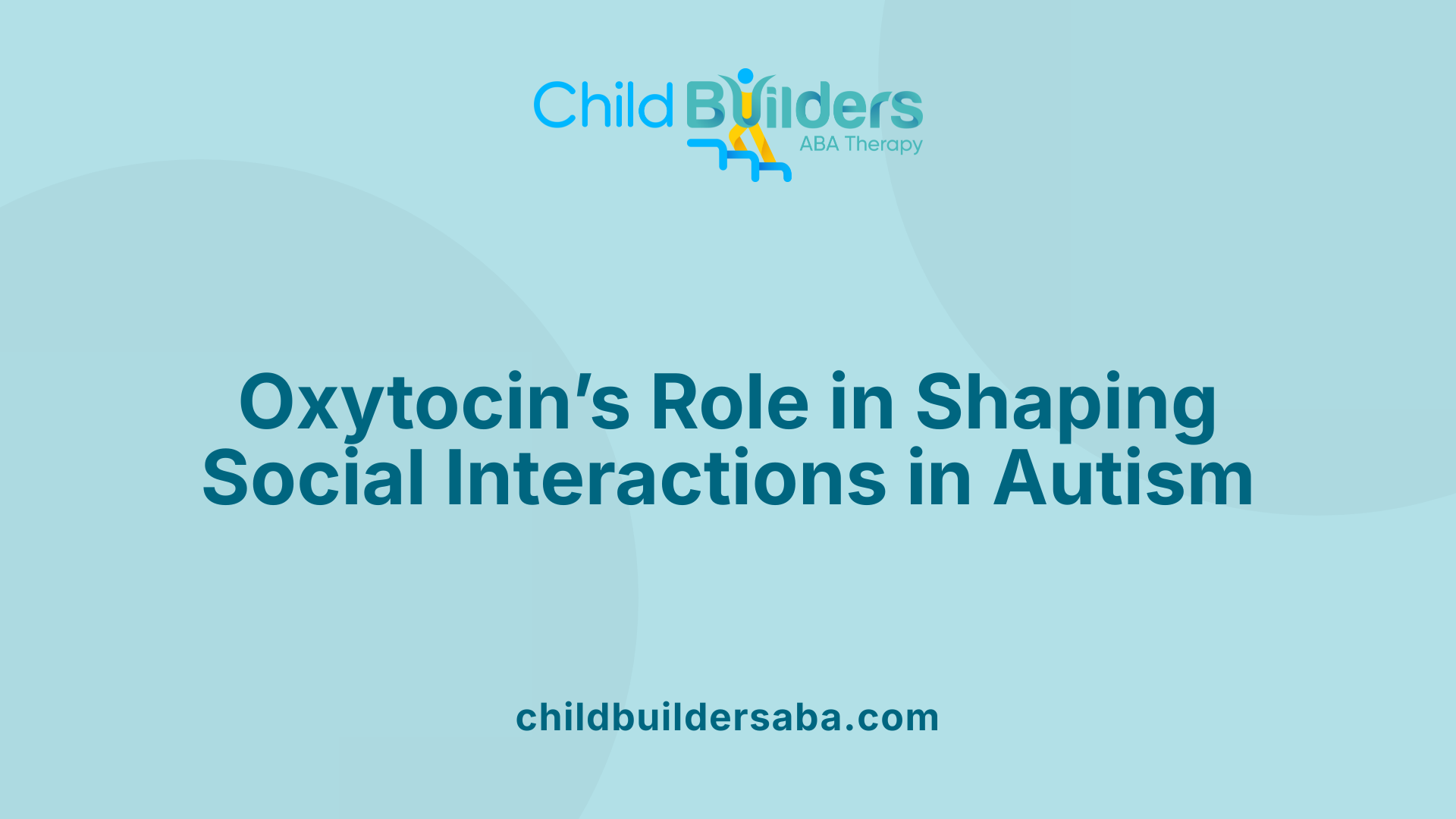
What is the scientific link between oxytocin and autism spectrum disorder (ASD)?
Research indicates that oxytocin, a hormone primarily produced in the hypothalamus, plays a key role in human social bonding, emotional recognition, and trust. In individuals with autism spectrum disorder (ASD), biological studies have demonstrated that blood and salivary oxytocin levels are often lower compared to neurotypical individuals. These reduced levels are associated with more severe social impairments, such as difficulty understanding social cues, reduced eye contact, and challenges in forming social bonds.
Numerous experimental and clinical studies have explored the possibility of using oxytocin therapeutically to improve social deficits in ASD. Intranasal oxytocin administration, in particular, has been found to temporarily increase endogenous oxytocin levels, which can lead to enhanced social cognition and behavior.
Neuroimaging evidence backs this up, showing that oxytocin influences activity in brain regions involved in social processing, such as the amygdala, medial prefrontal cortex, and nucleus accumbens. In children with ASD, oxytocin has been shown to reduce hyperactivation of the amygdala in response to social stimuli, which is often linked to social anxiety.
Moreover, studies suggest that oxytocin can affect neural circuits associated with social salience — the ability to recognize and respond to social cues. For example, increased oxytocin levels have been associated with greater gaze to the eyes, improved emotion recognition, and heightened trust during social interactions.
However, the effects of oxytocin are complex and vary among individuals. Not all children with ASD benefit equally from oxytocin treatment, which underscores the importance of understanding individual differences in baseline oxytocin levels and receptor sensitivity.
While current evidence is promising, the precise neurobiological mechanisms by which oxytocin modulates social behavior are not fully understood. Further research is necessary to determine optimal administration protocols, dosages, and treatment durations, as well as to explore the long-term effects of oxytocin therapy.
Overall, oxytocin's role in influencing social behavior makes it a compelling candidate for targeted interventions. Continued investigation into its biological mechanisms aims to pave the way for personalized treatment options for individuals with ASD, tailored to their specific neurochemical profiles.
| Aspect | Findings | Additional Details |
|---|---|---|
| Oxytocin levels in ASD | Often lower than in neurotypical children | Varies widely among individuals |
| Brain activity effects | Modulates amygdala and prefrontal cortex activity | Reduces social stress, enhances social reward |
| Behavioral impacts | Improves eye contact, emotional recognition | Effects are short-term and individual-dependent |
| Treatment approaches | Intranasal spray most common; variability in dose | Ongoing research to optimize protocols |
| Genetic and molecular links | Variations in oxytocin receptor gene (OXTR) linked to differences in social behavior | DNA methylation patterns suggest receptor regulation |
In summary, targetting the oxytocin system offers promising avenues for understanding and treating social impairments in ASD. As research progresses, its application may become more precise, supporting the development of personalized therapies that harness neurochemical pathways to improve social functioning.
Current Evidence on Oxytocin Levels and Social Impairments in ASD
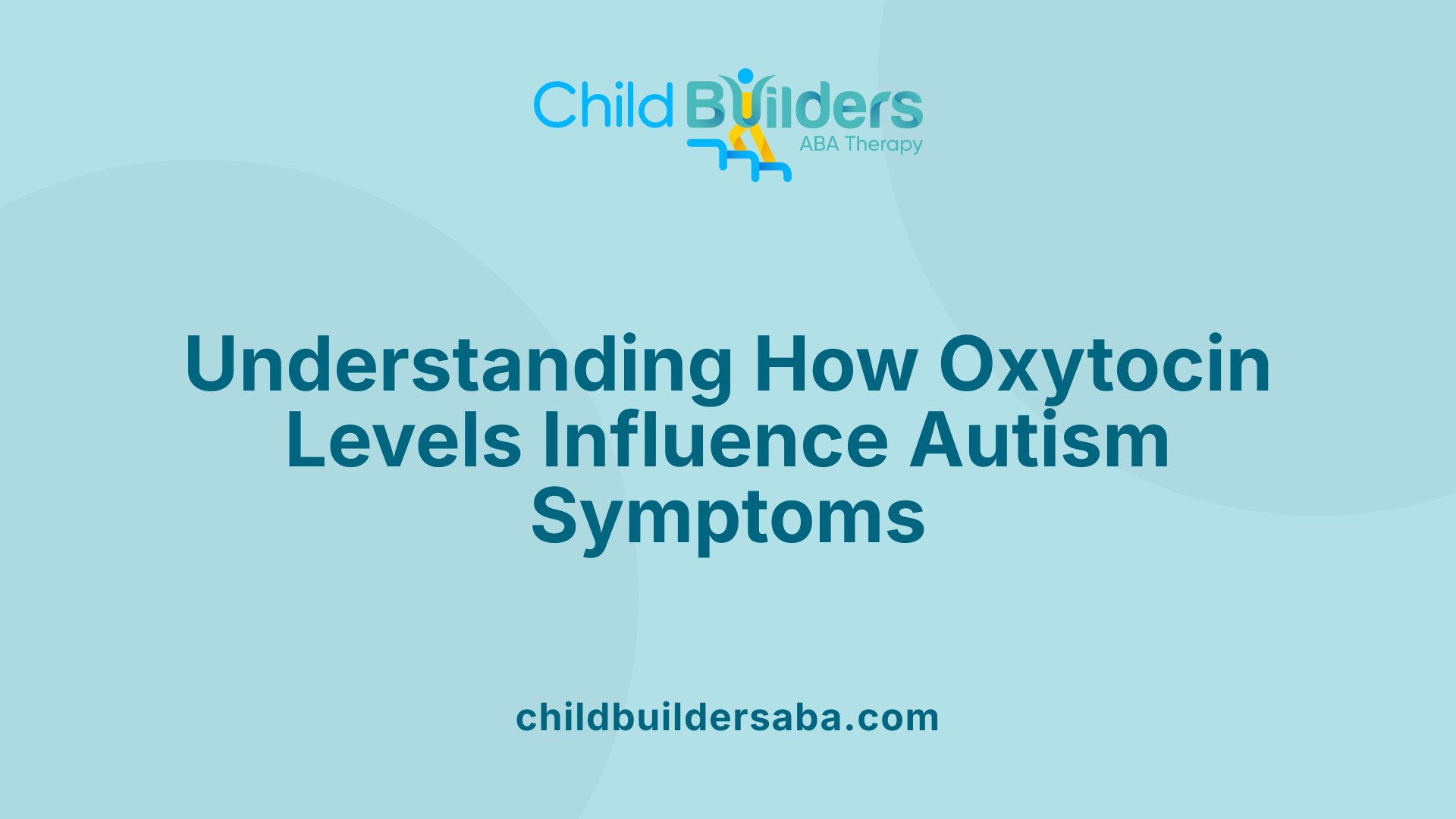
What are the current research findings on the effects of oxytocin on autism?
Recent scientific studies provide a complex picture of oxytocin's role in autism spectrum disorder (ASD). Oxytocin, a hormone crucial for social bonding and prosocial behaviors, has been the focus of many experimental and clinical trials as a potential treatment for social deficits in autistic individuals.
Some research, such as a 2017 study from Stanford, suggests that intranasal oxytocin can improve social behaviors, especially in children with low baseline oxytocin levels. In this study, 32 children with autism received oxytocin or placebo over four weeks, and those with initially low oxytocin showed notable benefits in social interactions, eye contact, and trust. Additionally, oxytocin was found to increase receptor expression, indicated by decreased OXTR DNA methylation, and to promote feelings of secure attachment.
However, evidence from larger, more comprehensive clinical trials has been mixed. A significant study published in the New England Journal of Medicine involved nearly 290 children and adolescents with ASD, who received oxytocin for 24 weeks. The results showed no meaningful improvements in social or cognitive functioning compared to the control group the same duration. This suggests that while oxytocin may have some benefits, these are not guaranteed for all individuals, and the treatment’s efficacy remains uncertain.
Research also indicates that oxytocin influence extends to neurobiological changes, such as increased activity in brain regions involved in social cognition—like the medial prefrontal cortex, nucleus accumbens, and superior temporal sulcus—and reductions in amygdala activity during social tasks. These neural effects support the idea that oxytocin can modulate key social processing pathways.
Furthermore, adjustments in oxytocin levels and OXTR methylation—an epigenetic marker influencing receptor expression—have been linked to social behavior improvements and stress regulation. For example, increased salivary oxytocin after intranasal administration correlated with decreased DNA methylation of OXTR and a sense of security, indicating biological underpinnings for behavioral changes.
Despite this promising evidence, many questions remain. Researchers highlight the need to optimize treatment methods, including dosing, duration, and age of administration. There is also a focus on identifying which individuals are most likely to respond based on genetic or biological markers, such as baseline oxytocin levels.
In summary, current research shows a pattern where oxytocin can influence social behaviors and underlying neural activity in some cases, but its effectiveness across diverse populations with ASD is inconsistent. More controlled studies are essential to confirm its therapeutic potential and to understand how to personalize treatment approaches.
Variability in oxytocin levels among individuals with autism
Blood oxytocin levels vary greatly among individuals with autism. Several studies consistently report that children with ASD tend to have lower plasma oxytocin levels compared to neurotypical children. Notably, low baseline levels are often associated with greater social impairments, such as difficulties in making eye contact, recognizing emotions, or establishing social bonds.
Conversely, a large-scale study involving nearly 200 children, including those with autism, their siblings, and neurotypical controls, showed that oxytocin levels did not universally characterize autism. In fact, the findings contradicted the expectation that children with autism would always exhibit the lowest oxytocin. Instead, the data revealed that oxytocin levels influenced social functioning regardless of diagnostic status, and genetic factors, including parental oxytocin levels, also played a significant role.
This variability helps explain why some autistic children respond favorably to oxytocin therapy, especially those with low levels at baseline, while others do not. It also underscores the importance of personalized medicine approaches, where biological markers guide treatment decisions.
In addition to peripheral blood measures, research indicates that oxytocin processing abnormalities may occur in the brain, influencing social behavior independently of blood levels. Therefore, further studies are needed to assess central oxytocin activity directly, such as through cerebrospinal fluid analysis.
Overall, these findings highlight that oxytocin levels are influenced by a combination of genetic, environmental, and developmental factors, resulting in significant individual differences within the autism population.
| Aspect | Findings | Additional Details |
|---|---|---|
| Blood oxytocin in ASD | Generally lower than in neurotypical children | Variability across individuals; associated with social impairments |
| Genetic influence | Parental oxytocin levels impact child’s oxytocin | Variations in OXTR gene and epigenetics are relevant |
| Response to treatment | Better responders often start with low baseline levels | Personalized approach may target responders |
| Cranial vs. blood oxytocin | Central levels in cerebrospinal fluid may differ from blood | Further research needed |
In light of these findings, the ongoing challenge is to refine oxytocin-based interventions, making them more targeted and effective based on individual biological profiles.
Methodologies in Studying Oxytocin and Autism
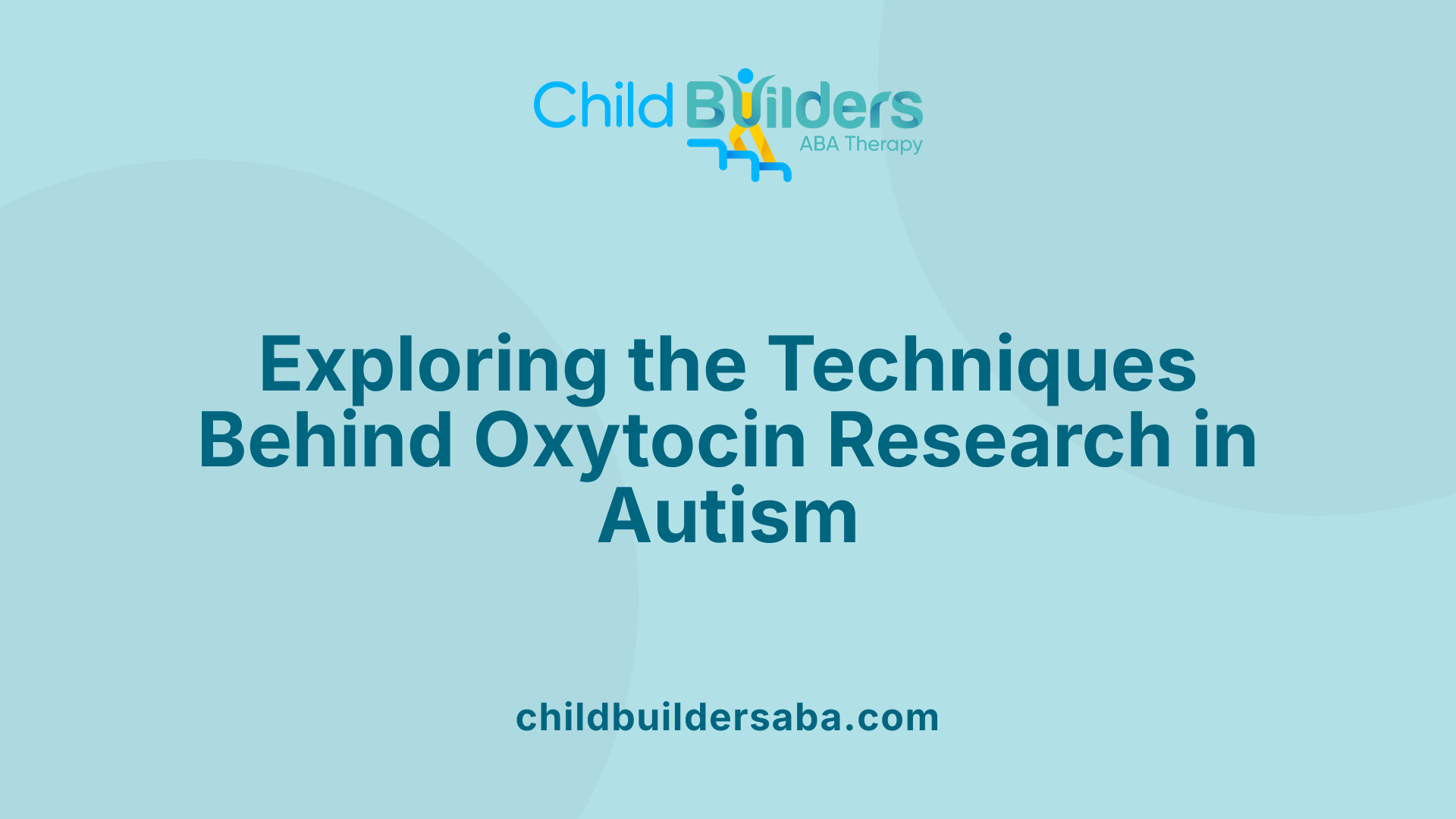
What research methodologies are used to study oxytocin's relationship with autism and what are their findings?
Research in this field employs a variety of scientific techniques to understand how oxytocin affects individuals with autism spectrum disorder (ASD). These include randomized controlled trials (RCTs), neuroimaging studies, genetic and epigenetic analyses, and behavioral assessments.
RCTs are among the primary methods used to evaluate the efficacy of oxytocin administration in improving social behaviors. Most of these trials involve giving intranasal oxytocin or placebo to participants, then measuring changes in social interaction, trust, emotion recognition, and social motivation through standardized scales and behavioral tasks. For example, some studies report that intranasal oxytocin temporarily enhances eye contact, reduces social anxiety, and improves social cognition.
Neuroimaging techniques, particularly functional magnetic resonance imaging (fMRI), are used to observe brain activity changes associated with oxytocin administration. These studies investigate how oxytocin influences neural circuits involved in social cognition, such as increased activation in the amygdala, prefrontal cortex, and reward-related regions like the nucleus accumbens. One study with 17 children with ASD found that a single dose of oxytocin increased activity in these social brain regions and decreased activity in areas related to nonsocial processing.
Genetic and epigenetic research focus on variations and modifications in the oxytocin receptor (OXTR) gene. Researchers analyze DNA methylation patterns, gene variants, and expression levels to identify biological factors that may influence the response to oxytocin treatment. For instance, some studies report that increased OXTR methylation is linked to social impairments, and oxytocin treatment can reduce DNA methylation at specific sites, potentially leading to increased receptor expression.
Behavioral assessments include social stimulation tasks, emotion recognition tests, and monitoring of real-world social interactions. These tools evaluate how oxytocin affects social engagement and emotional understanding. Studies suggest that children with low baseline oxytocin levels or certain genetic profiles might experience more significant benefits from oxytocin therapy.
Overall, these research methods contribute to a nuanced understanding of oxytocin's potential role in ameliorating social deficits in ASD. While some results are promising, especially regarding temporary improvements in social function, the consistency and longevity of these effects need further validation through larger, more robust studies.
The use of these methods underscores a comprehensive approach, combining biological, neurological, and behavioral data. This integrated perspective helps to clarify the complex relationship between oxytocin and social behavior in autism and guides future personalized treatment strategies.
| Methodology | Focus Area | Main Findings & Challenges |
|---|---|---|
| Randomized Controlled Trials (RCTs) | Social behavior improvement assessments | Mixed results; some show temporary benefits, others no effect |
| Neuroimaging (fMRI and PET scans) | Brain activity changes during social tasks | Increased activity in social brain areas, but variability exists |
| Genetic and Epigenetic Analyses | Oxytocin receptor gene (OXTR) variations & methylation | Some markers linked to social deficits; treatment response varies |
| Behavioral Assessments & Social Tasks | Social engagement, emotion recognition | Variable effects, often short-term enhancement |
Research continues to evolve, but current evidence points to a promising, albeit complex, relationship between oxytocin and social functioning in autism.
Biological and Neural Mechanisms Underlying Oxytocin's Impact in Autism
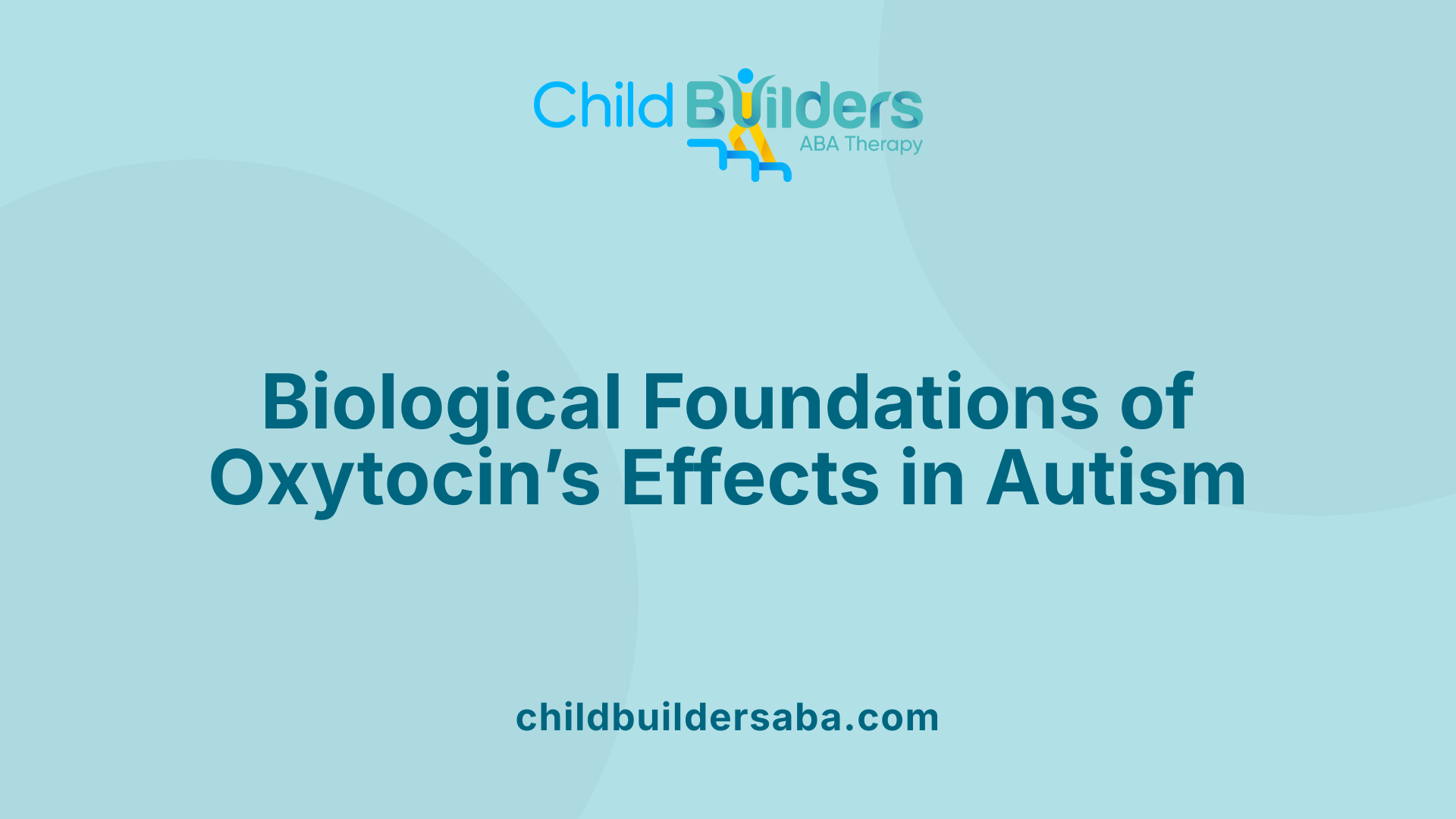
How is oxytocin produced and transmitted in the brain?
Oxytocin is a neuropeptide produced primarily in the hypothalamus, a vital brain region involved in hormone regulation and social behaviors. From the hypothalamus, oxytocin is released into the bloodstream via the posterior pituitary, and it also projects to various brain areas through neural pathways. These pathways serve to influence regions like the amygdala, prefrontal cortex, and nucleus accumbens, which are central to processing social cues, emotions, and reward.
What are the interactions with brain regions involved in social cognition?
Oxytocin interacts with key areas responsible for social cognition. For example, the amygdala plays a critical role in emotional recognition and social threat detection. Studies show that oxytocin administration can decrease amygdala reactivity, potentially reducing social anxiety. The prefrontal cortex is involved in higher-order social decision-making; oxytocin modulates activity here, promoting social engagement and understanding.
Another significant region is the nucleus accumbens, which mediates the rewarding aspects of social interactions. Activation of this area by oxytocin correlates with increased interest, trust, and social bonding. Functional MRI studies indicate that oxytocin enhances activity within these social neural circuits during exposure to social stimuli, especially in children with autism.
How do genetic variations affect the oxytocin system?
Variations within the oxytocin receptor gene (OXTR) can influence receptor expression and function, affecting how individuals respond to social cues. Some genetic polymorphisms in OXTR have been associated with increased autism risk, although they are not universally predictive. Research suggests these genetic differences can alter receptor density or sensitivity, leading to variability in social behavior and response to oxytocin-based therapies.
What are the effects of oxytocin on neural activity during social stimuli processing?
Administering oxytocin alters neural activity in several social brain regions. For instance, intranasal oxytocin increases activity in the medial prefrontal cortex, nucleus accumbens, and superior temporal sulcus during social judgment tasks in children with autism. These changes are associated with improved eye contact, social recognition, and reduced anxiety in social contexts.
Functional imaging studies further reveal that oxytocin decreases activity in the amygdala in response to social stimuli, which may alleviate social anxiety. Additionally, oxytocin’s influence on neural circuitry enhances the salience of social cues, making social engagement more rewarding and easier for individuals with autism. The neural modulation by oxytocin underpins its potential to improve social responsiveness and social cognition.
| Anatomical Region | Function in Social Cognition | Response to Oxytocin Administration |
|---|---|---|
| Hypothalamus | Produces and releases oxytocin | Source of oxytocin for neural pathways |
| Amygdala | Emotional recognition and threat processing | Reduced hyper-reactivity, less social anxiety |
| Prefrontal Cortex | Social decision-making and understanding | Increased activity, better social judgments |
| Nucleus Accumbens | Reward processing related to social behaviors | Enhanced activity linked to increased social interest |
| Superior Temporal Sulcus | Processing social cues like gaze and facial expressions | Increased activation during social stimuli processing |
Overall significance
Understanding these mechanisms highlights how the oxytocin system influences social cognition and behavior in autism. Variability in production, receptor function, and neural responsiveness may explain differences in social abilities among individuals with autism. These insights pave the way for targeted therapies that enhance oxytocin signaling, aiming to alleviate core social impairments.
Oxytocin and Neural Activation During Social Tasks in Autism
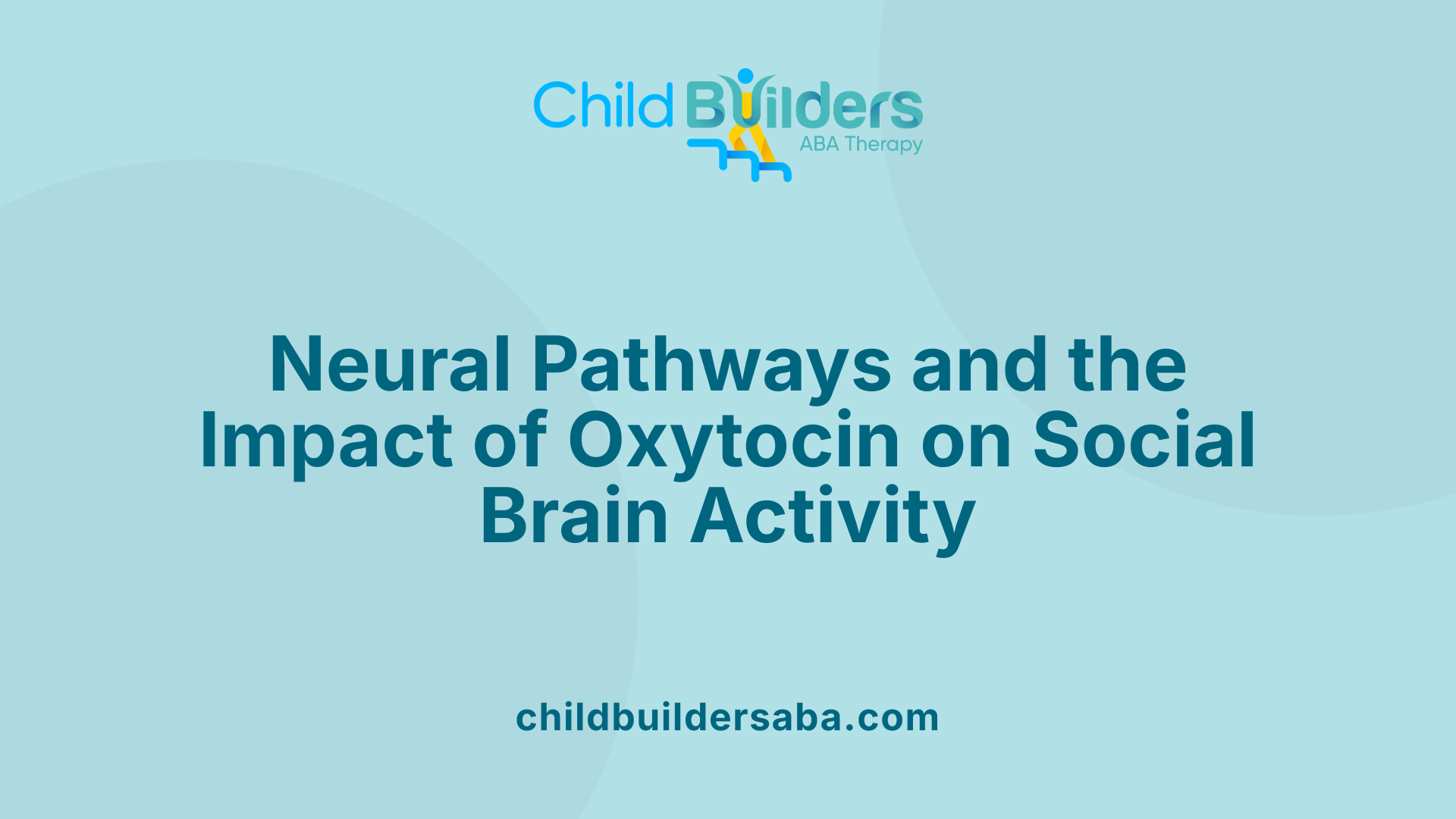
How does oxytocin influence social behaviors in individuals with autism?
Oxytocin plays a significant role in modulating social behaviors, especially in people with autism spectrum disorder (ASD). It enhances social cognition, emotional recognition, and social bonding, which are areas often affected in ASD. Research demonstrates that intranasal delivery of oxytocin can increase eye contact and gaze fixation on socially relevant stimuli, such as faces and eyes, fostering more meaningful social interactions.
Numerous studies have observed that individuals with autism tend to have lower baseline levels of oxytocin in their blood, correlating with greater social difficulties. Interestingly, those with the lowest oxytocin levels often experience more notable improvements following oxytocin treatment, highlighting its potential as a targeted therapy.
While oxytocin’s impact on improving social engagement is promising, its effects on reducing repetitive behaviors or anxiety have been inconsistent across studies. Most research focuses on short-term social gains, with some indicating enhanced trust, better social cue recognition, and increased responsiveness during social tasks.
Neuroimaging studies, especially functional magnetic resonance imaging (fMRI), provide insights into how oxytocin influences brain activity during social cognition tasks. These studies show that oxytocin administration results in increased activation in brain regions associated with social processing, including the amygdala, prefrontal cortex, and nucleus accumbens.
Understanding these neural changes helps clarify oxytocin’s potential mechanisms. For example, increased activity in the amygdala may relate to heightened emotional awareness, while engagement of the prefrontal cortex could support better social decision-making. The nucleus accumbens’ role in reward processing suggests that oxytocin might make social stimuli more rewarding, encouraging social behaviors.
Additionally, levels of salivary oxytocin post-administration have been linked with neural activity changes, making salivary measurement a promising biomarker for prediction and monitoring treatment responses. Studies utilizing double-blind, placebo-controlled designs with fMRI have confirmed that a single dose of oxytocin enhances activity in social brain circuits during social judgment tasks.
In summary, oxytocin influences neural activation by effectively tuning brain regions involved in social cognition, thereby improving social responsiveness in individuals with ASD. These neural effects correspond to behavioral enhancements, such as increased eye contact, trust, and social interest, supporting oxytocin’s role as a potential therapeutic agent for social deficits in autism.
| Brain Region | Activation Changes with Oxytocin | Behavioral Correlates | Additional Details |
|---|---|---|---|
| Amygdala | Increased activity | Reduced social anxiety, enhanced emotional recognition | Central to processing emotional and social stimuli |
| Prefrontal Cortex | Increased activity | Improved decision-making in social contexts | Supports social judgment and empathy |
| Nucleus Accumbens | Elevated response during social judgment | Increased social reward perception | Links to motivation for engaging in social activities |
| Superior Temporal Sulcus (STS) | Enhanced activity | Better recognition of socially relevant cues | Critical for gaze processing and understanding social intention |
Current Perspectives, Limitations, and Future Directions
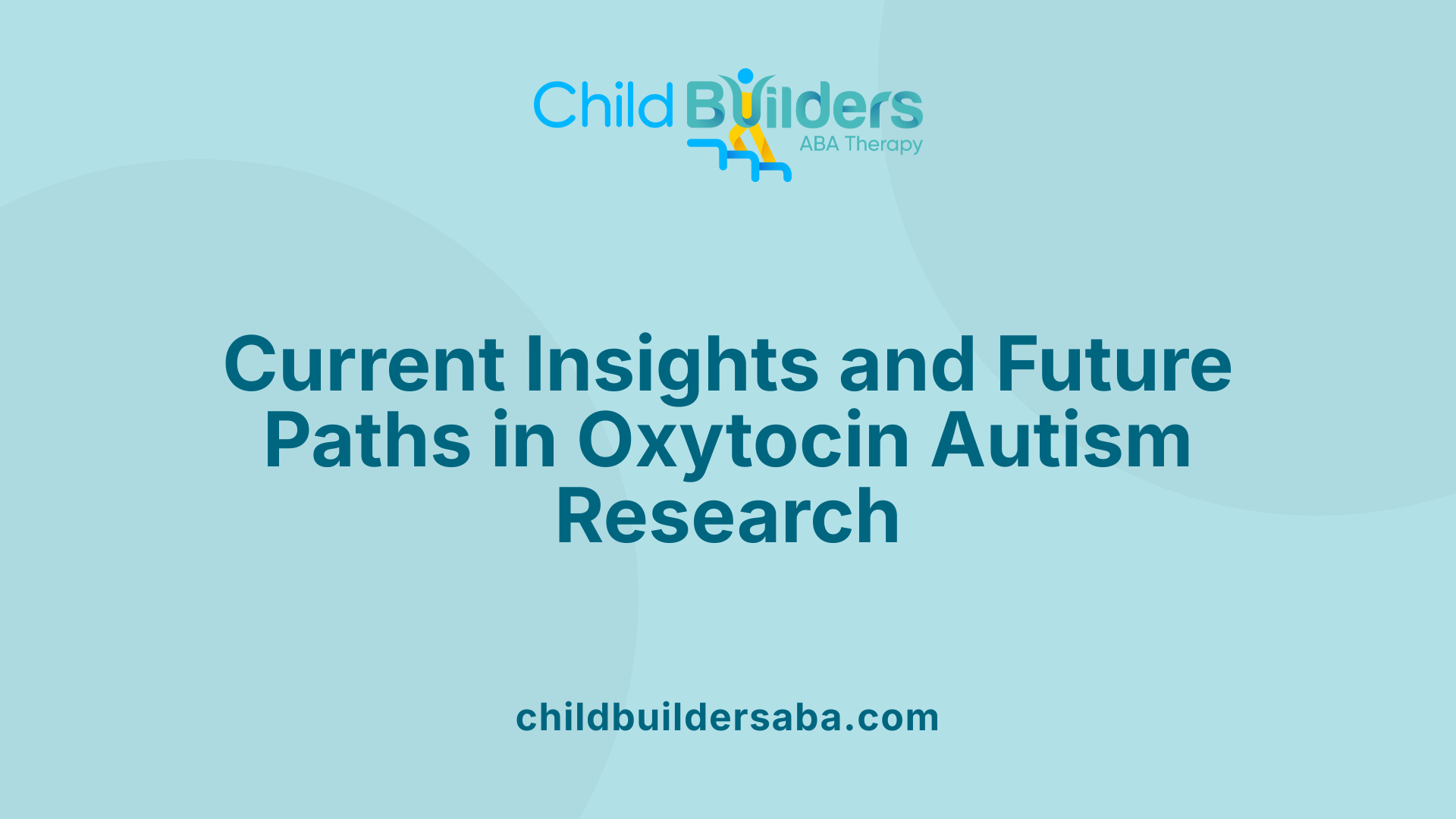
What are the considerations regarding the effectiveness, side effects, and therapeutic potential of oxytocin in autism treatment?
Oxytocin has garnered significant interest as a potential treatment for autism spectrum disorder (ASD), primarily because of its role in social bonding and cognition. Some research suggests that children with ASD, especially those with low baseline oxytocin levels, may experience improvements in social behavior following oxytocin administration. For instance, a study by Stanford researchers found that children with lower initial oxytocin showed more benefit from intranasal oxytocin, which increased social interactions and feelings of attachment.
However, the evidence is mixed. A large, 24-week, placebo-controlled trial involving children and adolescents with ASD found no significant differences between the oxytocin and control groups regarding social or cognitive functioning. This indicates that, in many cases, oxytocin may not provide substantial benefits. Additionally, results from systematic reviews and meta-analyses reveal a small but significant improvement in social outcomes, with an effect size of around 0.22. Yet, concerns about heterogeneity among studies and potential publication bias mean these findings should be interpreted with caution.
Regarding side effects, most studies report mild symptoms such as headaches, nasal discomfort, or nausea. The long-term safety of repeated oxytocin use remains less clear and warrants further research. The variability in patient responses adds complexity—some individuals respond strongly, while others show minimal or no benefit.
Collectively, current evidence suggests that oxytocin’s therapeutic potential is promising but limited. It may be most effective when combined with behavioral therapies or tailored to individuals with specific biological profiles. At present, its use outside research settings is not supported by definitive evidence.
What are the potential mechanisms to optimize treatment (dosage, delivery, timing)?
Optimizing oxytocin treatment involves understanding intricacies like dosage, delivery methods, timing, and frequency of administration. Most studies utilize intranasal delivery, with doses ranging from 3 IU to 48 IU. While some evidence suggests that higher doses can increase salivary and plasma oxytocin levels, the ideal dose for sustained behavioral effects remains unclear.
Delivery route is critical; nasal spray is preferred for direct brain access, but the absorption and distribution vary among individuals. Alternative approaches like sublingual lozenges or injections have been explored, though intranasal remains the most common due to practical considerations.
Timing also matters—some studies administer oxytocin multiple times daily over several weeks, aiming for neuroplastic effects, while others use short-term single doses to assess immediate neural changes. Recent findings indicate that repeated administration can increase oxytocin levels and alter gene methylation related to the oxytocin receptor (OXTR), which may influence responsiveness.
Moreover, understanding the optimal treatment duration and whether continuous versus intermittent dosing yields better outcomes is ongoing. Future research should systematically evaluate these variables, possibly considering developmental stages and individual neurobiological profiles.
How do genetic and neurobiological factors influence responsiveness?
Genetic variations, particularly in the oxytocin receptor gene (OXTR), play a role in individual differences in response to oxytocin therapy. For instance, methylation levels at specific OXTR CpG sites correspond with receptor expression and social functioning. Studies have shown that children with lower OXTR methylation, and hence potentially higher receptor availability, may respond better to oxytocin treatment.
Blood oxytocin levels also vary among individuals, with some autistic children exhibiting lower baseline levels compared to neurotypical controls. Interestingly, a study involving nearly 200 children indicated that low baseline oxytocin does not necessarily differentiate those with autism from typical children but does relate to social functioning.
Neurobiological factors, such as the functioning of the hypothalamic-pituitary-adrenal (HPA) axis and brain activity in regions involved in social cognition—like the amygdala, striatum, and prefrontal cortex—affect treatment responses. For example, the extent to which oxytocin administration alters activity in these regions correlates with behavioral improvements, suggesting that neuroimaging biomarkers might serve to predict responsiveness.
The importance of personalized approaches and biomarkers
Given the diversity among individuals with ASD, personalized approaches are essential. Biomarkers like baseline plasma oxytocin levels, OXTR methylation status, and neural activity patterns may guide decisions about who might benefit from oxytocin therapy.
Studies have shown that children with low oxytocin levels or specific genetic profiles may respond better, emphasizing the need for biomarker-driven stratification in future trials. Personalized treatment plans could incorporate biological markers, cognitive assessments, and behavioral profiles to optimize outcomes.
Need for larger, rigorous, preregistered studies
Despite promising preliminary findings, the current body of research is limited by small sample sizes, short durations, and inconsistent methodologies. To truly evaluate oxytocin’s therapeutic potential, future efforts should prioritize large-scale, well-powered, preregistered clinical trials.
Such studies should incorporate standardized dosing protocols, control for confounding variables, and include long-term safety assessments. Moreover, they should explore combining oxytocin with behavioral interventions and stratify participants based on genetic and neurobiological markers.
This rigorous approach will help clarify the conditions under which oxytocin may be beneficial, identify responders, and ultimately support evidence-based clinical guidelines for its use in treating autism.
Summary and Future Outlook on Oxytocin's Role in Autism
While research into the neuropeptide oxytocin suggests it holds promise for alleviating some social impairments in autism, existing studies present a mixed picture. Lower oxytocin levels correlate with greater social deficits, and preliminary evidence indicates that supplementing oxytocin may improve social engagement in selected individuals, especially those with low baseline levels. Neuroimaging and genetic studies uncover complex neural pathways and genetic factors influencing responsiveness, emphasizing the importance of personalized treatment approaches. Nonetheless, large-scale clinical trials have yielded inconsistent results, and the safety and long-term efficacy of oxytocin therapy require further investigation. Future research should focus on optimizing administration protocols, identifying biomarkers for response, and conducting larger, rigorous trials to establish its therapeutic potential definitively. In the meantime, oxytocin remains a promising but unconfirmed avenue in the quest to better understand and treat social deficits in autism.
References
- Researchers report new findings about oxytocin and ASD
- Study shows which children with autism respond best to oxytocin ...
- Chronic oxytocin administration stimulates the oxytocinergic system ...
- Oxytocin and Autism Spectrum Disorders - PubMed
- Oxytocin and autism: Insights from clinical trials and animal models
- Can oxytocin help improve social skills in kids with autism? It's ...
- Oxytocin therapy and autism | Raising Children Network
- Association of Epidural Analgesia, Oxytocin, and Risk of Autism ...
- Promoting social behavior with oxytocin in high-functioning autism ...
- The effects of oxytocin administration on social and routinized ...





































































































